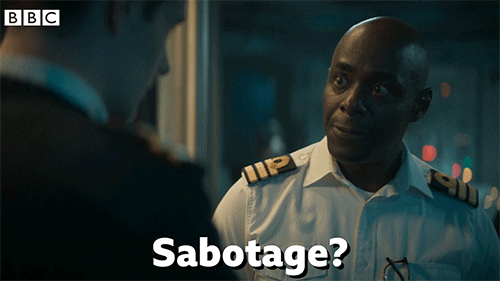
Sometimes I struggle writing about culture because a lot of aspects of culture feel outside HR’s control.
Like the fact we’re usually one of the later hires on an executive team or that most HR leaders are hired after there are already cultural issues.
HR leaders end up walking into situations that are more complicated than they need to be!
There’s one thing that has the largest and most direct impact on culture.
The leaders.
I wish picking your leadership team worked like your fantasy football roster where you put in your all-stars and then drop your not so great players. (I won my league last year, can you tell??)
Because HR can do great work to build a great company culture and ultimately if your leaders are terrible, it’s going to be an uphill battle.
Leaders set the tone for the entire organization and influence almost everything from:
- Vision
- Values
- Decision making
- Priorities
- Communication
- Hiring and promotions
That’s a lot of power especially when:
- 48% of people view their company leadership as “high quality”
- 77% of businesses report their leadership is lacking
- 5% of businesses have implemented leadership development at all levels
Oof.
Not to mention, having bad leaders can impact employee engagement to retention.
Knowing how to spot a bad leader could save your culture from further damage.
How to spot bad leaders:

“Some are born great, some achieve greatness and some have greatness thrust upon them.” – Billy Shakespeare
TBH: great leaders are rare.
Leadership is a skill few get a chance to actually hone before the responsibility is thrust upon them.
Meaning, HR teams are more likely to be dealing with the fallout from a leader’s behavior rather than reaping the rewards.
JOIN 130K+ HR LEADERS
Get insights, learnings, and advice on how to build companies and cultures that people actually love.
No spam. Unsubscribe any time.
Spotting bad behavior can feel like a superpower, so here are my top 4 traits of bad leaders, how they show up in the workplace, and how it impacts culture.
1. They lack empathy meaning they display an unwillingness or inability to understand the feelings, perspectives, or emotions of others. Leaders with a lack of empathy will:
- Disregard employee wellbeing
- Dismiss the challenges (personal or professional) employees are facing
- Display a lack of support for the team’s needs
- Be completely unaware of what their team is experiencing
How this impacts culture: lack of empathy can lead to teams with higher burnout and disengagement.
2. They don’t know how to communicate. Bad leaders will struggle with communicating needs and expectations and will:
- Withhold important information
- Avoid having tough conversations (feedback, etc)
- Give vague instructions on how to get something done
- Create team confusion and misunderstandings
How this impacts culture: poor communication can be the root cause of many issues like individuals feeling like they aren’t growing because they’re not getting feedback or teams confused because they don’t understand expectations.
3. They don’t take accountability. Bad leaders will display an inability to take ownership of a situation that has occurred as a result of actions taken and will:
- Blame others for failures or shortcomings
- Make excuses for the situation
- Avoid finding solutions
How this impacts culture: lack of accountability can lead to a blame culture and is one of the quickest ways to end up with a toxic environment
4. They aren’t consistent. Bad leaders will display unpredictability in action and decision-making and could:
- Give contradictory guidance
- Frequently change goals, objectives, and priorities
- Displaying favoritism
- Unevenly apply policies to employees
- Display erratic behavior or have unpredictable reactions
How this impacts culture: this can be a major contributor to inequity in the workplace where some employees feel others are treated better. It also creates a fear culture where employees are scared of a leader’s reaction.
Sometimes all 4 of these traits can exist in 1 human and it becomes clear the damage they are doing to the organization.
There is a chance to turn thing around but something you have to remember: there’s a difference between a bad leader that wants to be better and a bad leader who doesn’t seem capable of change.
Know which one you’re dealing with!
The next section will be for you if you have leaders capable and committed to change.
What to do with bad leaders:

Fire them. JK, sorry I couldn’t help myself.
We know that’s rarely the case. Maybe someday we can change that.
And I know it can feel damn near impossible to build great culture despite bad leaders.
What you don’t want to do: build culture initiatives, hope for the best, and not address the elephant in the room. You’ll set yourself up for failure with this approach.
Here are 3 tips on what to do with bad leaders (other than fire them).
#1: Build trust with them.
Sounds counterintuitive right? It’s not, I promise!
Many leaders might not inherently trust HR and sometimes we’re just viewed as a support function rather than a true strategic function. Building trust will be the key to a strong relationship and the foundation needed to deliver feedback.
You need trust to facilitate change.
You can build trust with a leader by:
- Being transparent, ex: sharing what you are observing
- Being authentic, ex: share why you care about culture
- Being reliable, ex: set action items and complete them
Signs of a trusting relationship between leadership <> HR:
- Communication is open and honest
- There is mutual respect
- Vulnerability is present
- Collaboration is easy
- Feedback goes both ways
Additional reading: 10 effective ways to build trust
#2: Give them feedback.
All leaders need feedback because no one is born a great leader! It is especially important that leaders continue to get consistent feedback because of the large impact they have on an organization.
Since you’ve already established trust with the leadership team (see #1) you are well-equipped to deliver that feedback!
Time out: I recognize it can feel exhausting to constantly be the one who has to give feedback and care as intensely as you probably do about culture. We know better than anyone else that little things add up to much bigger things. Something as small as how you communicate a departure can actually have major cultural implications. What I’ve learned is giving feedback and knowing what hills to die on can be a game changer. You can’t change everything so take it day by day! Okay time back in a la Zack Morris.
Additional reading:
#3: Collect employee feedback.
I debated including this one because employee’s rarely feel safe giving feedback.
But if there’s one thing that spooks bad leaders REAL QUICK it’s feedback from their team and their peers. Collecting that feedback might be the fastest way to change behaviors.
You can build your own surveys or utilize a tool like Gallup Q12. If you go your own survey route here are 20 questions you could ask.
Pro-tip: doing surveys once a quarter will get you quicker feedback for the team to iterate on.
Once you collect the feedback, don’t delay in putting together an action plan. In your action plan, you should share the aggregated results with action items for each of your leaders.
Additional reading: 4 steps to creating your culture plan
Building a great culture starts with recognizing where your weak spots exist.
Don’t forget: by focusing on your leadership team you will have the greatest and most direct impact on improving culture.
Don’t let bad leaders bring you down!

It’s very possible to build great cultures despite having less than great leaders.
Don’t forget:
- Build trust with your leadership team
- Keep your eye out for bad behaviors
- Give feedback and convey the impact of those behaviors on culture
- Collect AND present employee feedback
The worst thing you could do? Let the bad leaders be bad.
The flipside: If you have tried and you cannot change the leaders and/or their behaviors remember that not every environment deserves you.
Make your plan and protect your mental health!
Next week, I’m going to dive into team culture VS company culture.
Spoiler alert: sometimes there is a disconnect!
Cliffhanger


